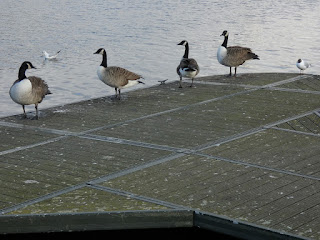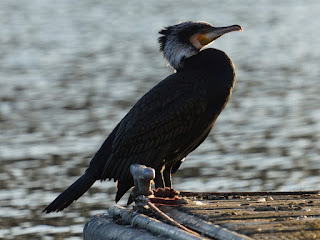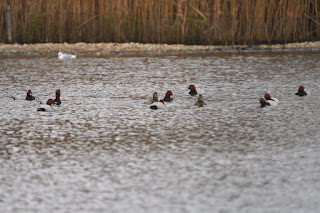A small flock of Redwings hunted worms in the mud on the Parade Ground.
They were finding a lot.
A Great Tit happily ignored gravity and walked down a tree trunk head first. Like Nuthatches and Treecreepers, they look for insects in cracks in the bark.
A Long-Tailed Tit was also looking for insects in a tree on Buck Hill.
And there are insects to be had even in midwinter. I was taking a routine picture of a rabbit and found I had accidentally captured a swarm of midges.
Beside the leaf yard something edible was getting the close attention of a group of Carrion Crows and a squirrel. They were too busy to fight. Maybe there was an ants' nest, but do squirrels eat ants?
The Little Owl was back in the old squirrel drey at the top of Buck Hill. Again, she was almost hidden, but it was good to know that she was there.
It looks as if there is a sitting Grey Heron in one of the nests on the island. A couple of weeks ago Paul saw a heron settling down in this nest, and today you could just see the top of a head above the twigs.
Black-Headed Gulls and a Common Gull squabbled over a morsel of food.
The aggressive Black-Headed Gull on the landing stage was annoyed to find Canada Geese on his territory, but they were too big to chase off.
A Cormorant stood on the platform at Bluebird Boats. It fishes under the edge of the platform where fish lurk in the shadows.
The Mute Swans in the Italian Garden used the spray from the fountain to wet their feathers and make them easy to preen.
Often the Pochards on the Long Water are impossible to see, but today they had come out in the open.
A group bustled around a Black-Headed Gull.
The late afternoon sun lit up the gilding on the Albert Memorial. I am very fond of this absurd structure. A friend is writing a book about it which promises to be the definitive work on the subject.












Is that going to be a reference book, or a monograph? I'd like to know more about the project.
ReplyDeleteThe aggressive gull has been out-aggressed. Canadas are not to be messed with.
The picture of the Blue Tit defying gravity is incredible!
It's going to be a full-sized book: history, architecture, materials (the author is a geologist), sculpture (including a full description of the people in the Parnassus frieze), other artistic details.
ReplyDeleteMore fine Redwing shots! Seeing few here & only had one small flock at Lynford Arboretum on a long Norfolk weekend birding (though an unexpected White-tailed Eagle on the beach at Thornahm was a real highlight!).
ReplyDeleteGood to see you have a reasonable number of Pochard. I counted 5 when I did my WeBS count at Lonsdale Rd Res on Monday. Returning from Norfolk on Sunday we finished at Welney where there were several hundred, mostly smart males as the females tend to migrate further south (though don't really noticed this sex discrepancy in London where we have smaller numbers).
There were about 18 Redwings here, some in Hyde Park and some in Kensington Gardens. Still not a lot, but numbers seem to be increasing daily.
DeleteI counted 14 Pochards on Monday, though I think there were a few more lurking in the bushes. A few years ago the BTO asked for a one-off survey of sex ratios of Pochards, and I found at least three males for every female in the park.
Interesting.
ReplyDelete